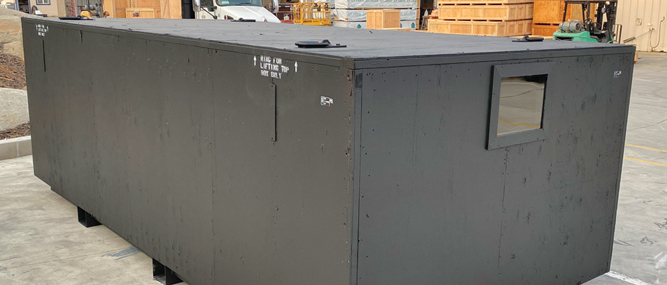Valley Box (www.valleybox.com) is a leading supplier of crating based in San Diego, California. It was founded in 1965 by Jim Eschwege and continues to thrive today. Alicia Guillette, his granddaughter, leads the third-generation company. “Wooden containers are the #1 packaging choice when durability, flexibility, and performance are critical and are for loads from 700 lbs. up to 10,000 lbs.,” Guillette explained.
Valley Box takes pride in its role in educating customers and sharing its best practices with the industry at large. With this in mind, Valley Box provided Pallet Enterprise with a “glimpse under the lid” of two innovative packaging solutions — a material handling cart for heavy parts and a container with an observation port to prevent overseas product damage.
Case Study #1: Material Handling Cart to Prevent Work-in-Process Product Damage
The first case study involves an industrial ring manufacturer concerned about product damage. During an annual quality control evaluation, the company discovered that 10% of its rings were discarded due to excessive damage from transport between multiple manufacturing floors.
Valley Box designed material handling carts to support the most common-sized ring, produced with the aid of the ring manufacturer’s quality control team. The new design featured ergonomically rounded steel tubing, flat steel edges to protect against rough handling, side openings for easier part access, paint for product identification and heavy-duty casters for heavier loads.
Aside from allowing color coding for quick part identification, painting wooden containers can offer other benefits, including ultraviolet protection, prolonged lifespan and enhanced appearance.
The pushcarts effectively supported the weight of each ring, allowing them to be moved efficiently and without incident to the multiple warehouses. Since the first material handling cart design, the industrial ring manufacturer has experienced a significant decrease in discarded rings. Other benefits include improved shop floor control, better access to parts and enhanced personnel safety.
Carts were also designed for different-sized rings following the successful launch of the initial cart.
Case Study #2: Container with Observation Port Designed to Prevent Corrosion Damage
In the second case study, a packaging equipment manufacturer was looking for a solution to the delays and damage resulting from overseas customs inspections. Outbound shipments were being held up at foreign ports of entry because the containers had to be opened entirely to be inspected by customs officials. After inspection, the improperly resealed containers ultimately led to a 26% damage rate to shipments due to corrosion.
Valley Box added an observation port on the side of the container to meet customs requirements for verifying the contents. The port also allowed a view of the internal moisture indicator to ensure the package continued to be appropriately sealed. Added weather stripping keeps the port water-resistant, and high-grade plexiglass is resistant to impact from rough handling.
To ensure the company was fully stocked with corrosion prevention products needed to protect the equipment’s delicate instruments, Valley Box also initiated an inventory surveillance program.
As a result of the added observation port, corrosion damages were reduced to zero. Additionally, customs inspection time decreased, improving on-time delivery performance and customer satisfaction. To find out more about Valley Box, visit www.valleybox.com.




